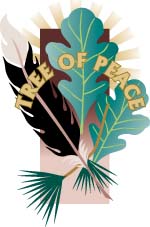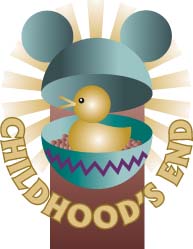PLACE OF PEACE
I came to work in Mrak Hall in 1984, the same year that the Peace Tree was planted on its west side. Seventeen years passed without my having noticed the tree or its small plaque. So when I learned that a blessing would take place during Native American Cultural Days at a tree next to Mrak, I went—to be a part of the cultural days activities, to get outside on a pretty spring day and to find out more about this "peace tree" and why it was worthy of a blessing.
On May 12, 1984, Chief Jake Swamp, an Iroquois elder, traveled from New York to UC Davis to plant a California Valley oak, Quercus lobata, in recognition of the campus's Native American Cultural Days and to give a blessing. He asked people to bury any past hard feelings toward their adversaries and to renew the bonds of good will.
Today it's a fine strong tree, though not tall enough to command attention among the many towering redwoods on that side of Mrak, and 12 of us circled it in a loose ring waiting for the ceremony to begin. One person turned off her cell phone. Another checked his Palm Pilot while we waited to see if anyone else would come. The blessing was to be given by George Longfish, professor of Native American Studies. Feeling like a Baptist at a Catholic mass, I watched him pull a rawhide-tied bundle of white sage from a narrow black box that looked like it might have held a nicely packaged tie or trio of handkerchiefs.
George Longfish is also Iroquois—from the Seneca and Tuscarora tribes. He's an artist, not a medicine man, known for his luscious color paintings with their abstract indigenous symbols. But he's been with the department nearly 30 years, almost since its founding, and is, thus, an elder in his own right.
Longfish walked around the ring, giving each of us a small bit of the sage, then used a match to light the rest. He gently fanned the fragrant smoke with an eagle feather.
Tradition holds that the smoke from the sage can cleanse the spirit and calm chaos. The smoke rises to a higher source, like the eagle, whose soaring flight allows him to communicate with the creator. The person who owns an eagle feather shares a connection with this higher power.
"Say hello to the planet," Longfish began, speaking softly. "Say hello to the sky. Say hello to yourself as a spirit."
Native American culture holds, as have religions throughout time, that an individual is both body and spirit, and that power resides with the spirit. Too many people today have lost touch with their spiritual side, Longfish believes, and—unable to draw on its power—fail to take control of their lives. They remain mired in petty problems.
"Envision a grounding chord," he continued, "a chain, a tube, a tree, water, anything that connects you to the center of the planet. Feel it pulling at the base of your spine, feel it pulling on your heart. You are grounded, you are rooted, as is the tree."
In native culture, the center of the earth is considered a place of transformation, where negative energy is changed into positive. Bad feelings, bad thoughts, problems slip down a grounding chord, are transformed and returned as positive energy.
As the blessing continued, Longfish spoke of the tree, recalled its planting so many years ago by Jake Swamp, tribal chair of the Iroquois. It was planted with the hope that the dream of the Peacemaker—a world without war—would one day come true.
The Iroquois is an allegiance of six peoples in the northeastern United States: the Mohawks, Oneidas, Onondagas, Cayugas, Senecas and Tuscaroras. They were warring tribes that were brought together many centuries ago, legend tells us, by a great peacemaker named Deganawiduh, the Messenger of the Good Tidings of Peace and Power. Deganawiduh traveled from tribe to tribe forging an alliance and building a tripartite form of governance that would last through time and eventually serve as a model for the U.S. government. Its symbol was a pine tree, a Tree of Great Long Leaves. Its top stretched to the heavens; its roots—the White Roots of Peace—spread north, east, south, west, extending the law, the peace to all people. Under its sheltering branches, representatives from the six tribes would meet and consult.
Longfish pointed out the significance of the tree's symbolism to native culture—which so values the earth and nature—and to the campus today. "Jake Swamp planted the tree at a time when the Native American program at Davis was struggling. But like the tree the department has grown."
Native American Studies was launched in 1969, a time when students were increasingly demanding relevancy in their courses. When Longfish came in 1973 it was still just a tiny program, with a lot of energy but only budding academic promise. Today it is one of the top Indian programs in the country. New faculty, from fine institutions, have been recruited. In 1993 it became a full-fledged department, one of only a handful in the United States. Later that decade, a Rockefeller Foundation Humanities Fellowship provided four years of funding to strengthen its programming. And it has recently begun offering a doctoral degree—only the second university in the nation to do so.
The blessing was coming to a close, and Longfish spoke once again to us as individuals. "It is nature's way to grow. You, too, are growing. Acknowledge that. Vindicate yourselves. Remember why you are here on this earth. You are blessed."
Longfish went around the circle again, stopping for a moment with each of us to encourage us to crush our bit of sage between our fingers and inhale its fragrance. I did and remembered my roots—the sage-strewn prairies of Wyoming—and felt touched by the personal blessing I had received. I had gone to the ceremony expecting to be an observer. To perhaps learn more about a campus tree—one of many with a story only hinted at by a tiny plaque beneath. And I came away with a blessing.
— Teri Bachman, M.A. '82


Elated giggles and gleeful squeals drifted to my ears on my way to class. Turning to look, I spied a group of children screeching with excitement as they played tag on the muddy Quad. About 20 feet away, another pack of tots flapped their arms like wings, imitating the ducks that had waddled up to join the fun.
I grinned. I longed to run over and play the game, to quack back at the curious creatures that had come to visit. I nearly bumped into a passing student before realizing that he was watching the children as well. Looking around, I found that we were not alone—all of the other "kids" our age were grinning widely and spying on our little guests. But with this warm, happy feeling came a surge of panic—did the impending end of college mean the end of childhood?
College for most of us means independence, a chance to be on our own for the first time. I get to pay my own bills with the checkbook I acquired when I was 16. I get to go to the grocery store with my roommates and stock up on soda and ramen. I can stay up as late as I want, and sometimes paper-writing requires I stay up even longer than that. But with this newfound responsibility and independence comes a feeling of nostalgia, and I realize I'm not so grown up after all—at least I don't want to be quite yet.
I still love getting up early on Saturday to curl up with a bowl of cereal and watch cartoons. I still go to Disneyland at least once a year and feel the same sense of elation when I get to shake Minnie's hand as I did when I was 5. When I get sick, I want to lie down and watch Goonies, my favorite movie when I was 9. I still find myself staying up half the night to finish a level on a video game. And I still can't sleep the night before Christmas.
So, I wonder, after June 17 rolls around and I move my tassel to the left side, will all this come to an end? Do I trade in my Disneyland fund for stocks and bonds and throw away my Harry Potter collection in favor of the latest in Oprah's book club? Watching the kids on the Quad as they grow happier the dirtier they get, I promise myself one thing: The first thing I'll do after I cross that stage in Rec Hall will be to tear off my cap and gown and go play in the mud—right before I catch the next plane to Anaheim.
— Kristine Wickson '01

|

